Report: Impact of Employee Training on Organizational Success
VerifiedAdded on 2021/06/17
|10
|2562
|136
Report
AI Summary
This report provides a comprehensive analysis of the impact of employee training on organizational success. It begins by highlighting the importance of training in today's competitive market, where technological advancements demand continuous skill development. The report explores various benefits of employee training, including improved performance, reduced operational costs, and decreased employee turnover. It also discusses how training enhances an organization's competitiveness, provides opportunities for promotions, reduces the need for supervision, creates a pool of talents, and fosters team spirit. The report emphasizes the importance of budgeting for employee training and adapting training programs to meet future needs, such as those related to digital business and social media marketing. Overall, the report underscores the crucial role of employee training in ensuring an organization's continuity and success in a dynamic environment.
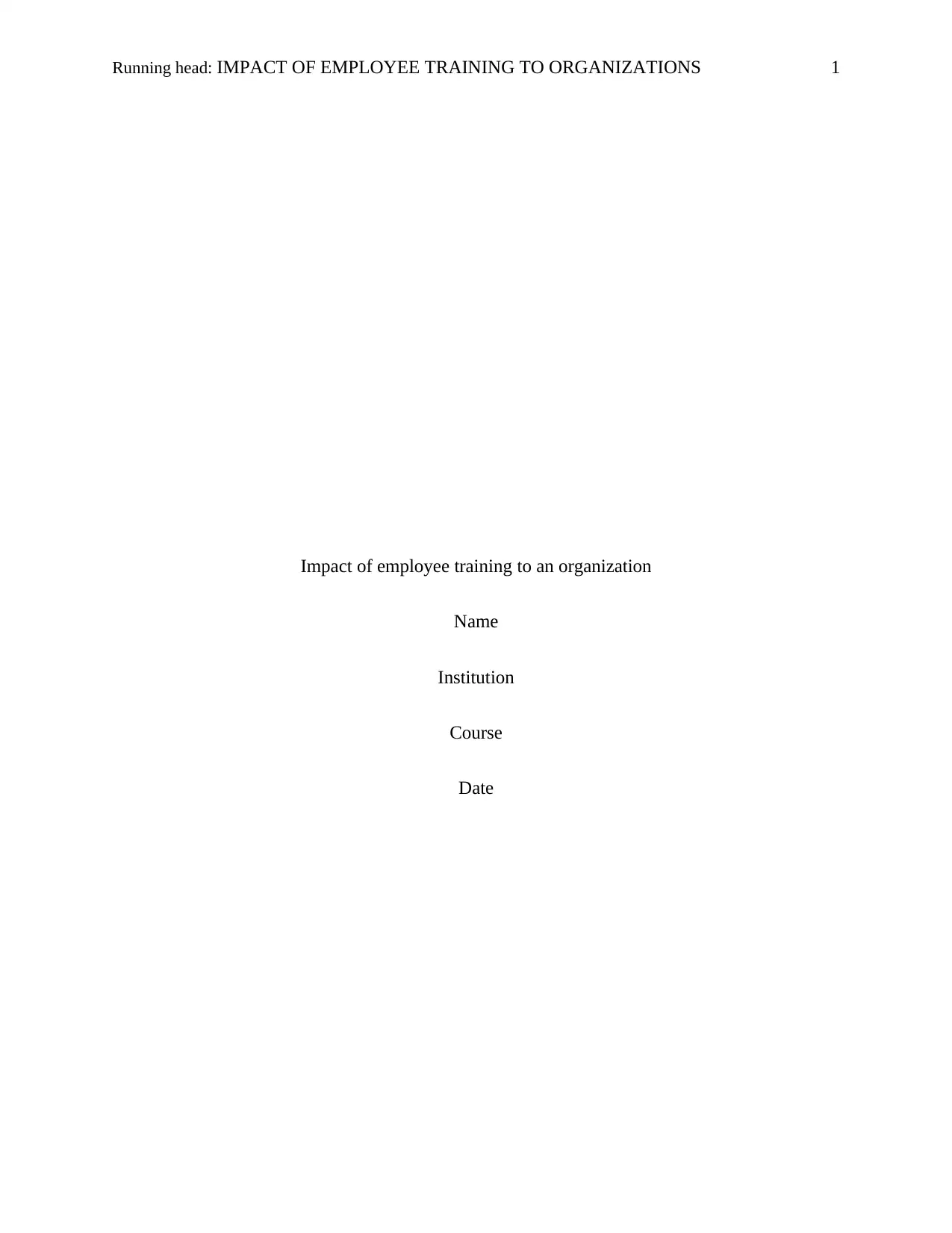
Running head: IMPACT OF EMPLOYEE TRAINING TO ORGANIZATIONS 1
Impact of employee training to an organization
Name
Institution
Course
Date
Impact of employee training to an organization
Name
Institution
Course
Date
Paraphrase This Document
Need a fresh take? Get an instant paraphrase of this document with our AI Paraphraser
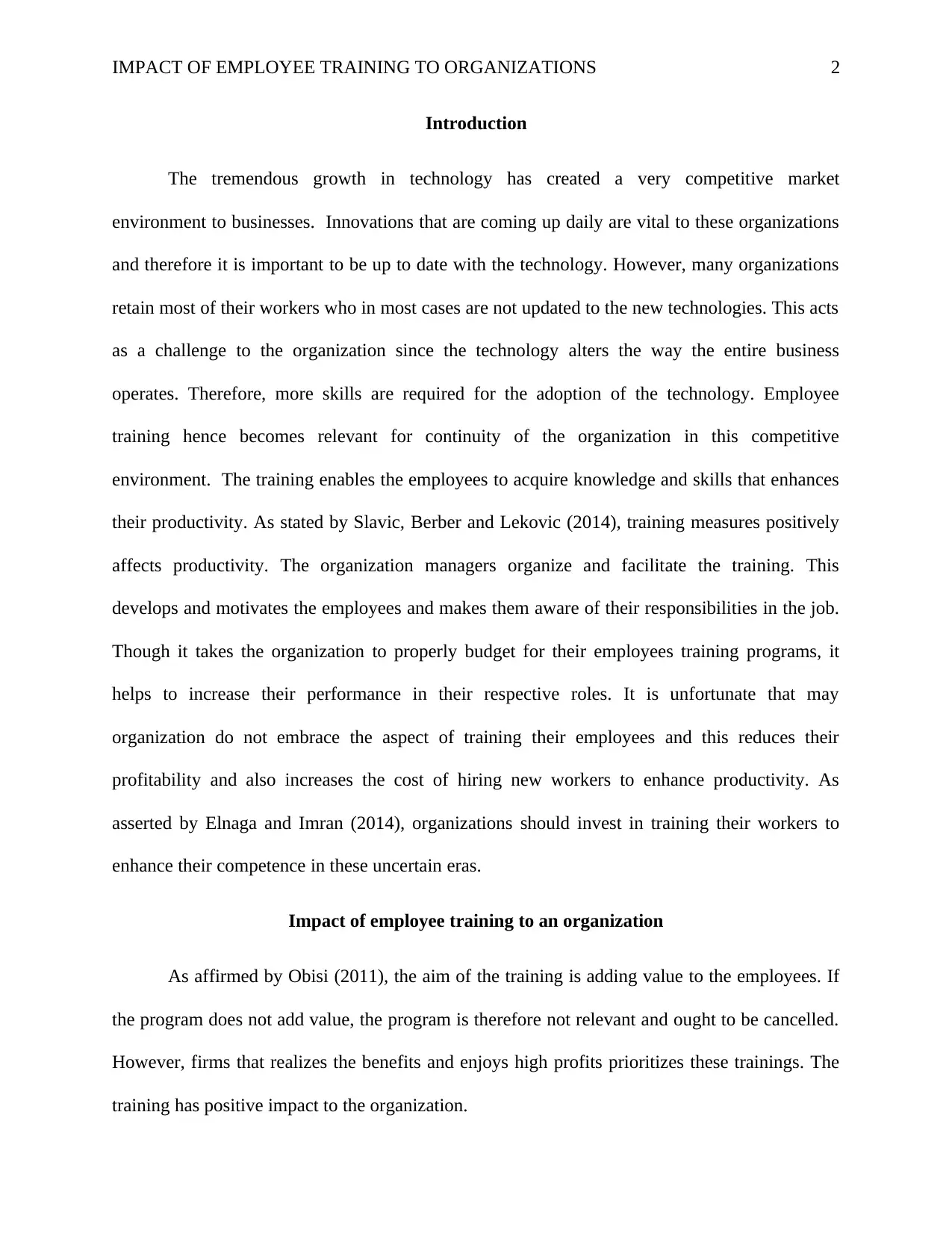
IMPACT OF EMPLOYEE TRAINING TO ORGANIZATIONS 2
Introduction
The tremendous growth in technology has created a very competitive market
environment to businesses. Innovations that are coming up daily are vital to these organizations
and therefore it is important to be up to date with the technology. However, many organizations
retain most of their workers who in most cases are not updated to the new technologies. This acts
as a challenge to the organization since the technology alters the way the entire business
operates. Therefore, more skills are required for the adoption of the technology. Employee
training hence becomes relevant for continuity of the organization in this competitive
environment. The training enables the employees to acquire knowledge and skills that enhances
their productivity. As stated by Slavic, Berber and Lekovic (2014), training measures positively
affects productivity. The organization managers organize and facilitate the training. This
develops and motivates the employees and makes them aware of their responsibilities in the job.
Though it takes the organization to properly budget for their employees training programs, it
helps to increase their performance in their respective roles. It is unfortunate that may
organization do not embrace the aspect of training their employees and this reduces their
profitability and also increases the cost of hiring new workers to enhance productivity. As
asserted by Elnaga and Imran (2014), organizations should invest in training their workers to
enhance their competence in these uncertain eras.
Impact of employee training to an organization
As affirmed by Obisi (2011), the aim of the training is adding value to the employees. If
the program does not add value, the program is therefore not relevant and ought to be cancelled.
However, firms that realizes the benefits and enjoys high profits prioritizes these trainings. The
training has positive impact to the organization.
Introduction
The tremendous growth in technology has created a very competitive market
environment to businesses. Innovations that are coming up daily are vital to these organizations
and therefore it is important to be up to date with the technology. However, many organizations
retain most of their workers who in most cases are not updated to the new technologies. This acts
as a challenge to the organization since the technology alters the way the entire business
operates. Therefore, more skills are required for the adoption of the technology. Employee
training hence becomes relevant for continuity of the organization in this competitive
environment. The training enables the employees to acquire knowledge and skills that enhances
their productivity. As stated by Slavic, Berber and Lekovic (2014), training measures positively
affects productivity. The organization managers organize and facilitate the training. This
develops and motivates the employees and makes them aware of their responsibilities in the job.
Though it takes the organization to properly budget for their employees training programs, it
helps to increase their performance in their respective roles. It is unfortunate that may
organization do not embrace the aspect of training their employees and this reduces their
profitability and also increases the cost of hiring new workers to enhance productivity. As
asserted by Elnaga and Imran (2014), organizations should invest in training their workers to
enhance their competence in these uncertain eras.
Impact of employee training to an organization
As affirmed by Obisi (2011), the aim of the training is adding value to the employees. If
the program does not add value, the program is therefore not relevant and ought to be cancelled.
However, firms that realizes the benefits and enjoys high profits prioritizes these trainings. The
training has positive impact to the organization.
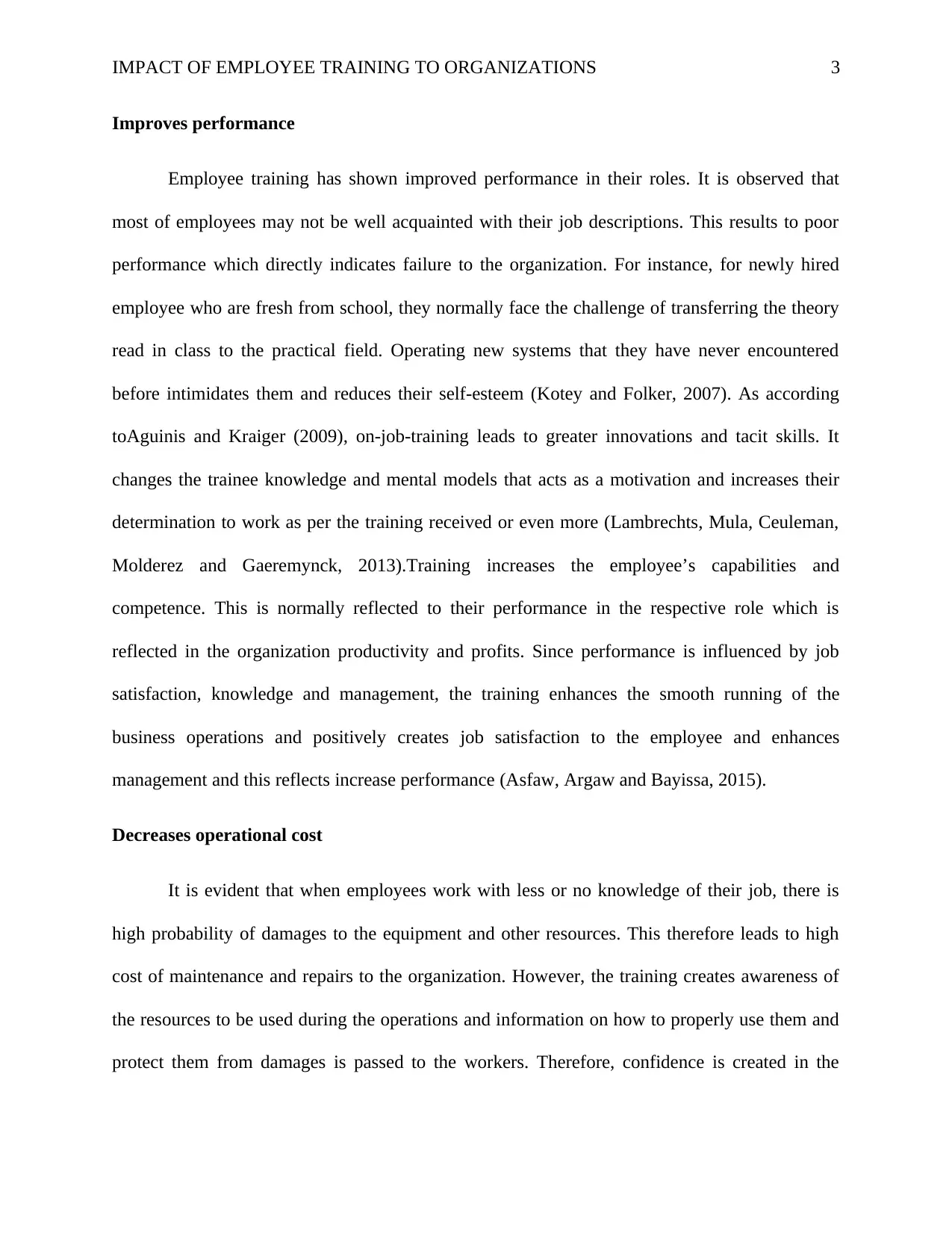
IMPACT OF EMPLOYEE TRAINING TO ORGANIZATIONS 3
Improves performance
Employee training has shown improved performance in their roles. It is observed that
most of employees may not be well acquainted with their job descriptions. This results to poor
performance which directly indicates failure to the organization. For instance, for newly hired
employee who are fresh from school, they normally face the challenge of transferring the theory
read in class to the practical field. Operating new systems that they have never encountered
before intimidates them and reduces their self-esteem (Kotey and Folker, 2007). As according
toAguinis and Kraiger (2009), on-job-training leads to greater innovations and tacit skills. It
changes the trainee knowledge and mental models that acts as a motivation and increases their
determination to work as per the training received or even more (Lambrechts, Mula, Ceuleman,
Molderez and Gaeremynck, 2013).Training increases the employee’s capabilities and
competence. This is normally reflected to their performance in the respective role which is
reflected in the organization productivity and profits. Since performance is influenced by job
satisfaction, knowledge and management, the training enhances the smooth running of the
business operations and positively creates job satisfaction to the employee and enhances
management and this reflects increase performance (Asfaw, Argaw and Bayissa, 2015).
Decreases operational cost
It is evident that when employees work with less or no knowledge of their job, there is
high probability of damages to the equipment and other resources. This therefore leads to high
cost of maintenance and repairs to the organization. However, the training creates awareness of
the resources to be used during the operations and information on how to properly use them and
protect them from damages is passed to the workers. Therefore, confidence is created in the
Improves performance
Employee training has shown improved performance in their roles. It is observed that
most of employees may not be well acquainted with their job descriptions. This results to poor
performance which directly indicates failure to the organization. For instance, for newly hired
employee who are fresh from school, they normally face the challenge of transferring the theory
read in class to the practical field. Operating new systems that they have never encountered
before intimidates them and reduces their self-esteem (Kotey and Folker, 2007). As according
toAguinis and Kraiger (2009), on-job-training leads to greater innovations and tacit skills. It
changes the trainee knowledge and mental models that acts as a motivation and increases their
determination to work as per the training received or even more (Lambrechts, Mula, Ceuleman,
Molderez and Gaeremynck, 2013).Training increases the employee’s capabilities and
competence. This is normally reflected to their performance in the respective role which is
reflected in the organization productivity and profits. Since performance is influenced by job
satisfaction, knowledge and management, the training enhances the smooth running of the
business operations and positively creates job satisfaction to the employee and enhances
management and this reflects increase performance (Asfaw, Argaw and Bayissa, 2015).
Decreases operational cost
It is evident that when employees work with less or no knowledge of their job, there is
high probability of damages to the equipment and other resources. This therefore leads to high
cost of maintenance and repairs to the organization. However, the training creates awareness of
the resources to be used during the operations and information on how to properly use them and
protect them from damages is passed to the workers. Therefore, confidence is created in the
⊘ This is a preview!⊘
Do you want full access?
Subscribe today to unlock all pages.

Trusted by 1+ million students worldwide
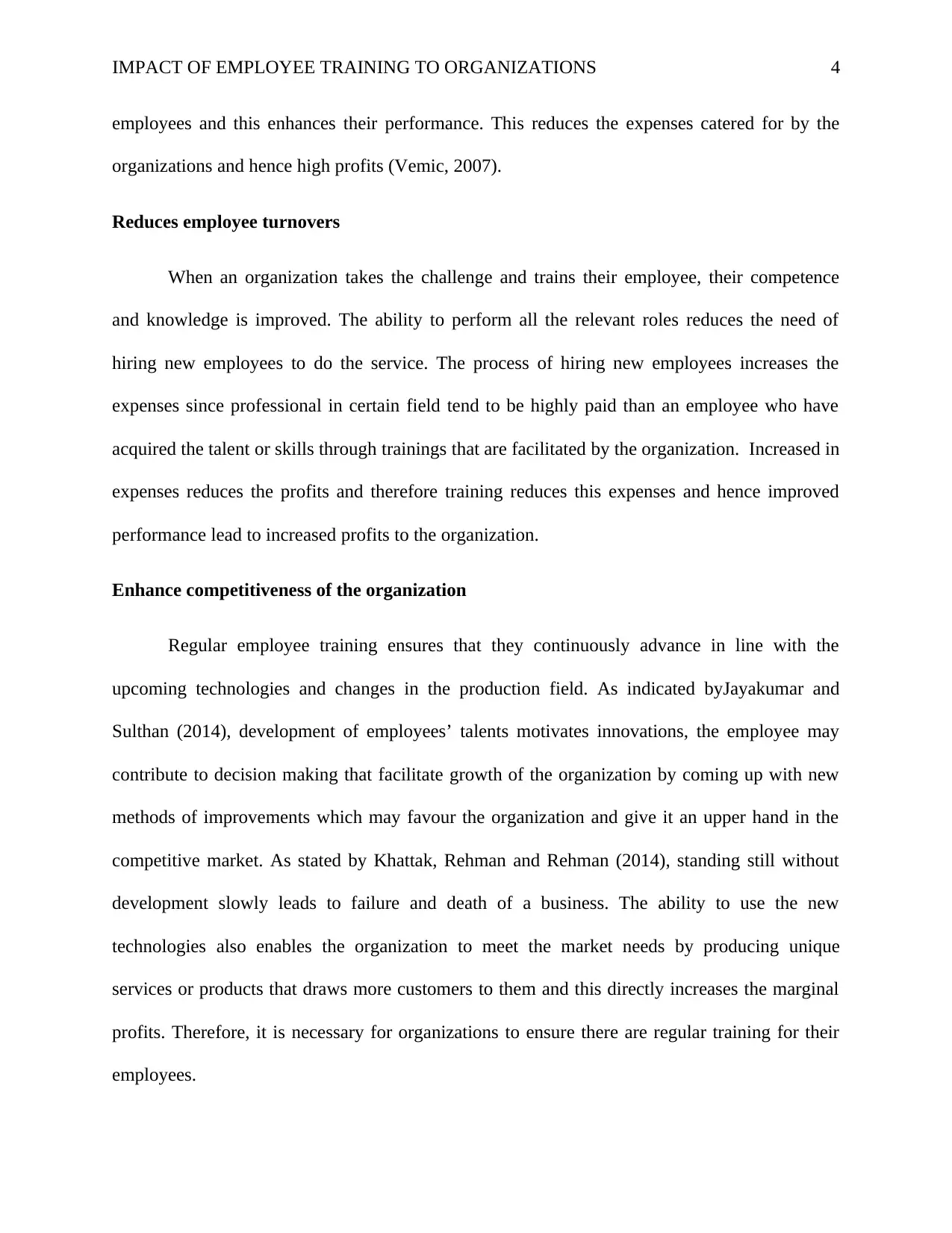
IMPACT OF EMPLOYEE TRAINING TO ORGANIZATIONS 4
employees and this enhances their performance. This reduces the expenses catered for by the
organizations and hence high profits (Vemic, 2007).
Reduces employee turnovers
When an organization takes the challenge and trains their employee, their competence
and knowledge is improved. The ability to perform all the relevant roles reduces the need of
hiring new employees to do the service. The process of hiring new employees increases the
expenses since professional in certain field tend to be highly paid than an employee who have
acquired the talent or skills through trainings that are facilitated by the organization. Increased in
expenses reduces the profits and therefore training reduces this expenses and hence improved
performance lead to increased profits to the organization.
Enhance competitiveness of the organization
Regular employee training ensures that they continuously advance in line with the
upcoming technologies and changes in the production field. As indicated byJayakumar and
Sulthan (2014), development of employees’ talents motivates innovations, the employee may
contribute to decision making that facilitate growth of the organization by coming up with new
methods of improvements which may favour the organization and give it an upper hand in the
competitive market. As stated by Khattak, Rehman and Rehman (2014), standing still without
development slowly leads to failure and death of a business. The ability to use the new
technologies also enables the organization to meet the market needs by producing unique
services or products that draws more customers to them and this directly increases the marginal
profits. Therefore, it is necessary for organizations to ensure there are regular training for their
employees.
employees and this enhances their performance. This reduces the expenses catered for by the
organizations and hence high profits (Vemic, 2007).
Reduces employee turnovers
When an organization takes the challenge and trains their employee, their competence
and knowledge is improved. The ability to perform all the relevant roles reduces the need of
hiring new employees to do the service. The process of hiring new employees increases the
expenses since professional in certain field tend to be highly paid than an employee who have
acquired the talent or skills through trainings that are facilitated by the organization. Increased in
expenses reduces the profits and therefore training reduces this expenses and hence improved
performance lead to increased profits to the organization.
Enhance competitiveness of the organization
Regular employee training ensures that they continuously advance in line with the
upcoming technologies and changes in the production field. As indicated byJayakumar and
Sulthan (2014), development of employees’ talents motivates innovations, the employee may
contribute to decision making that facilitate growth of the organization by coming up with new
methods of improvements which may favour the organization and give it an upper hand in the
competitive market. As stated by Khattak, Rehman and Rehman (2014), standing still without
development slowly leads to failure and death of a business. The ability to use the new
technologies also enables the organization to meet the market needs by producing unique
services or products that draws more customers to them and this directly increases the marginal
profits. Therefore, it is necessary for organizations to ensure there are regular training for their
employees.
Paraphrase This Document
Need a fresh take? Get an instant paraphrase of this document with our AI Paraphraser
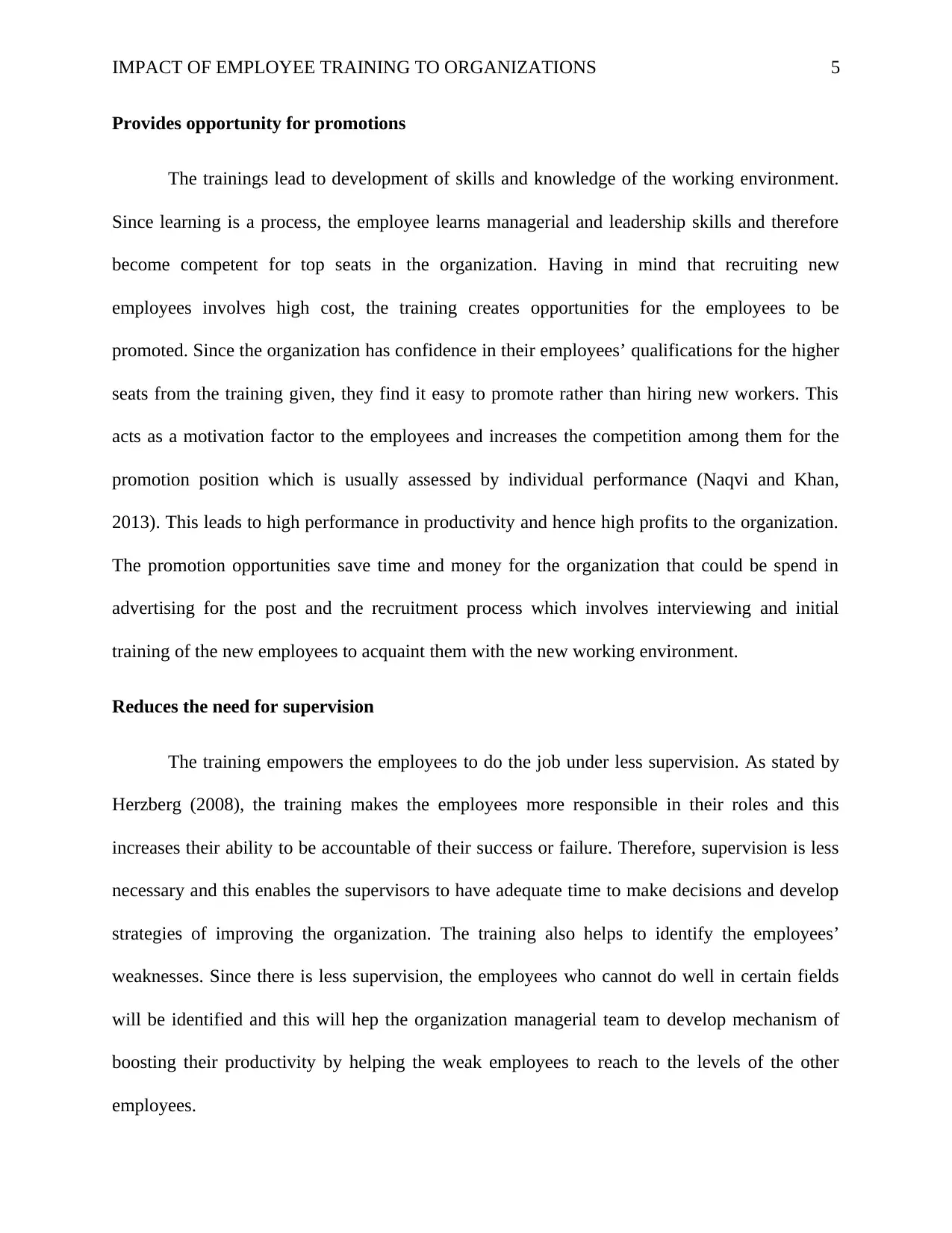
IMPACT OF EMPLOYEE TRAINING TO ORGANIZATIONS 5
Provides opportunity for promotions
The trainings lead to development of skills and knowledge of the working environment.
Since learning is a process, the employee learns managerial and leadership skills and therefore
become competent for top seats in the organization. Having in mind that recruiting new
employees involves high cost, the training creates opportunities for the employees to be
promoted. Since the organization has confidence in their employees’ qualifications for the higher
seats from the training given, they find it easy to promote rather than hiring new workers. This
acts as a motivation factor to the employees and increases the competition among them for the
promotion position which is usually assessed by individual performance (Naqvi and Khan,
2013). This leads to high performance in productivity and hence high profits to the organization.
The promotion opportunities save time and money for the organization that could be spend in
advertising for the post and the recruitment process which involves interviewing and initial
training of the new employees to acquaint them with the new working environment.
Reduces the need for supervision
The training empowers the employees to do the job under less supervision. As stated by
Herzberg (2008), the training makes the employees more responsible in their roles and this
increases their ability to be accountable of their success or failure. Therefore, supervision is less
necessary and this enables the supervisors to have adequate time to make decisions and develop
strategies of improving the organization. The training also helps to identify the employees’
weaknesses. Since there is less supervision, the employees who cannot do well in certain fields
will be identified and this will hep the organization managerial team to develop mechanism of
boosting their productivity by helping the weak employees to reach to the levels of the other
employees.
Provides opportunity for promotions
The trainings lead to development of skills and knowledge of the working environment.
Since learning is a process, the employee learns managerial and leadership skills and therefore
become competent for top seats in the organization. Having in mind that recruiting new
employees involves high cost, the training creates opportunities for the employees to be
promoted. Since the organization has confidence in their employees’ qualifications for the higher
seats from the training given, they find it easy to promote rather than hiring new workers. This
acts as a motivation factor to the employees and increases the competition among them for the
promotion position which is usually assessed by individual performance (Naqvi and Khan,
2013). This leads to high performance in productivity and hence high profits to the organization.
The promotion opportunities save time and money for the organization that could be spend in
advertising for the post and the recruitment process which involves interviewing and initial
training of the new employees to acquaint them with the new working environment.
Reduces the need for supervision
The training empowers the employees to do the job under less supervision. As stated by
Herzberg (2008), the training makes the employees more responsible in their roles and this
increases their ability to be accountable of their success or failure. Therefore, supervision is less
necessary and this enables the supervisors to have adequate time to make decisions and develop
strategies of improving the organization. The training also helps to identify the employees’
weaknesses. Since there is less supervision, the employees who cannot do well in certain fields
will be identified and this will hep the organization managerial team to develop mechanism of
boosting their productivity by helping the weak employees to reach to the levels of the other
employees.
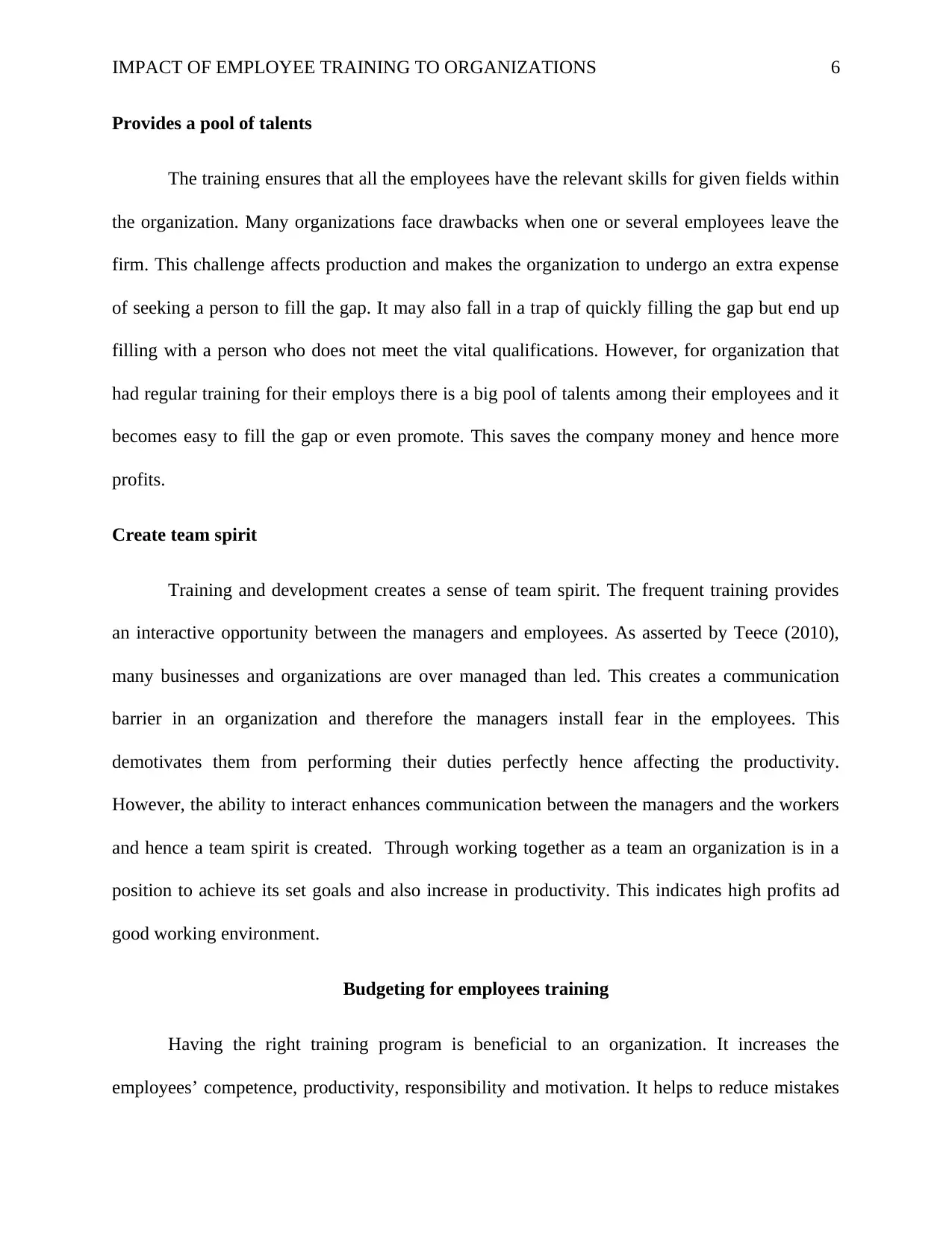
IMPACT OF EMPLOYEE TRAINING TO ORGANIZATIONS 6
Provides a pool of talents
The training ensures that all the employees have the relevant skills for given fields within
the organization. Many organizations face drawbacks when one or several employees leave the
firm. This challenge affects production and makes the organization to undergo an extra expense
of seeking a person to fill the gap. It may also fall in a trap of quickly filling the gap but end up
filling with a person who does not meet the vital qualifications. However, for organization that
had regular training for their employs there is a big pool of talents among their employees and it
becomes easy to fill the gap or even promote. This saves the company money and hence more
profits.
Create team spirit
Training and development creates a sense of team spirit. The frequent training provides
an interactive opportunity between the managers and employees. As asserted by Teece (2010),
many businesses and organizations are over managed than led. This creates a communication
barrier in an organization and therefore the managers install fear in the employees. This
demotivates them from performing their duties perfectly hence affecting the productivity.
However, the ability to interact enhances communication between the managers and the workers
and hence a team spirit is created. Through working together as a team an organization is in a
position to achieve its set goals and also increase in productivity. This indicates high profits ad
good working environment.
Budgeting for employees training
Having the right training program is beneficial to an organization. It increases the
employees’ competence, productivity, responsibility and motivation. It helps to reduce mistakes
Provides a pool of talents
The training ensures that all the employees have the relevant skills for given fields within
the organization. Many organizations face drawbacks when one or several employees leave the
firm. This challenge affects production and makes the organization to undergo an extra expense
of seeking a person to fill the gap. It may also fall in a trap of quickly filling the gap but end up
filling with a person who does not meet the vital qualifications. However, for organization that
had regular training for their employs there is a big pool of talents among their employees and it
becomes easy to fill the gap or even promote. This saves the company money and hence more
profits.
Create team spirit
Training and development creates a sense of team spirit. The frequent training provides
an interactive opportunity between the managers and employees. As asserted by Teece (2010),
many businesses and organizations are over managed than led. This creates a communication
barrier in an organization and therefore the managers install fear in the employees. This
demotivates them from performing their duties perfectly hence affecting the productivity.
However, the ability to interact enhances communication between the managers and the workers
and hence a team spirit is created. Through working together as a team an organization is in a
position to achieve its set goals and also increase in productivity. This indicates high profits ad
good working environment.
Budgeting for employees training
Having the right training program is beneficial to an organization. It increases the
employees’ competence, productivity, responsibility and motivation. It helps to reduce mistakes
⊘ This is a preview!⊘
Do you want full access?
Subscribe today to unlock all pages.

Trusted by 1+ million students worldwide
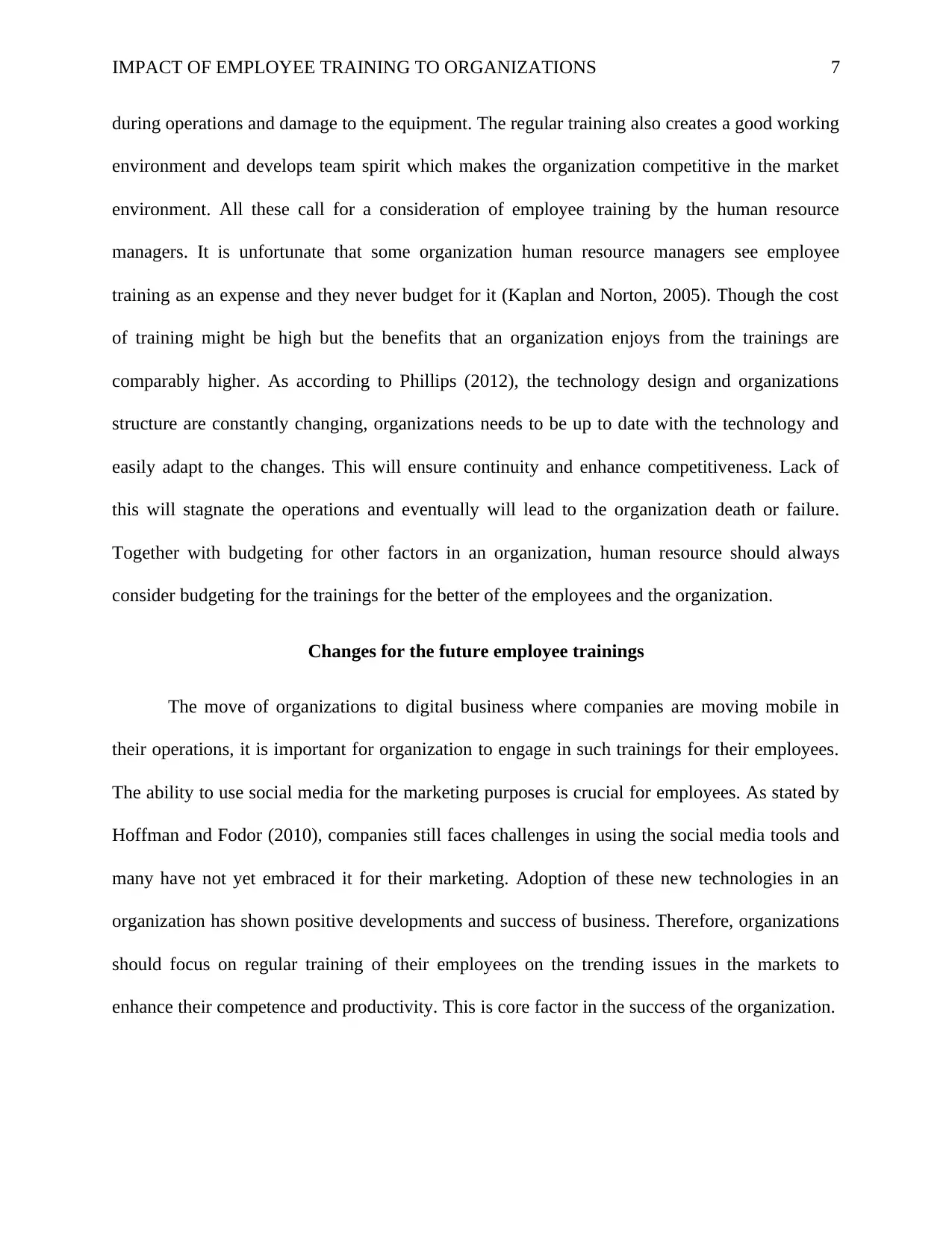
IMPACT OF EMPLOYEE TRAINING TO ORGANIZATIONS 7
during operations and damage to the equipment. The regular training also creates a good working
environment and develops team spirit which makes the organization competitive in the market
environment. All these call for a consideration of employee training by the human resource
managers. It is unfortunate that some organization human resource managers see employee
training as an expense and they never budget for it (Kaplan and Norton, 2005). Though the cost
of training might be high but the benefits that an organization enjoys from the trainings are
comparably higher. As according to Phillips (2012), the technology design and organizations
structure are constantly changing, organizations needs to be up to date with the technology and
easily adapt to the changes. This will ensure continuity and enhance competitiveness. Lack of
this will stagnate the operations and eventually will lead to the organization death or failure.
Together with budgeting for other factors in an organization, human resource should always
consider budgeting for the trainings for the better of the employees and the organization.
Changes for the future employee trainings
The move of organizations to digital business where companies are moving mobile in
their operations, it is important for organization to engage in such trainings for their employees.
The ability to use social media for the marketing purposes is crucial for employees. As stated by
Hoffman and Fodor (2010), companies still faces challenges in using the social media tools and
many have not yet embraced it for their marketing. Adoption of these new technologies in an
organization has shown positive developments and success of business. Therefore, organizations
should focus on regular training of their employees on the trending issues in the markets to
enhance their competence and productivity. This is core factor in the success of the organization.
during operations and damage to the equipment. The regular training also creates a good working
environment and develops team spirit which makes the organization competitive in the market
environment. All these call for a consideration of employee training by the human resource
managers. It is unfortunate that some organization human resource managers see employee
training as an expense and they never budget for it (Kaplan and Norton, 2005). Though the cost
of training might be high but the benefits that an organization enjoys from the trainings are
comparably higher. As according to Phillips (2012), the technology design and organizations
structure are constantly changing, organizations needs to be up to date with the technology and
easily adapt to the changes. This will ensure continuity and enhance competitiveness. Lack of
this will stagnate the operations and eventually will lead to the organization death or failure.
Together with budgeting for other factors in an organization, human resource should always
consider budgeting for the trainings for the better of the employees and the organization.
Changes for the future employee trainings
The move of organizations to digital business where companies are moving mobile in
their operations, it is important for organization to engage in such trainings for their employees.
The ability to use social media for the marketing purposes is crucial for employees. As stated by
Hoffman and Fodor (2010), companies still faces challenges in using the social media tools and
many have not yet embraced it for their marketing. Adoption of these new technologies in an
organization has shown positive developments and success of business. Therefore, organizations
should focus on regular training of their employees on the trending issues in the markets to
enhance their competence and productivity. This is core factor in the success of the organization.
Paraphrase This Document
Need a fresh take? Get an instant paraphrase of this document with our AI Paraphraser
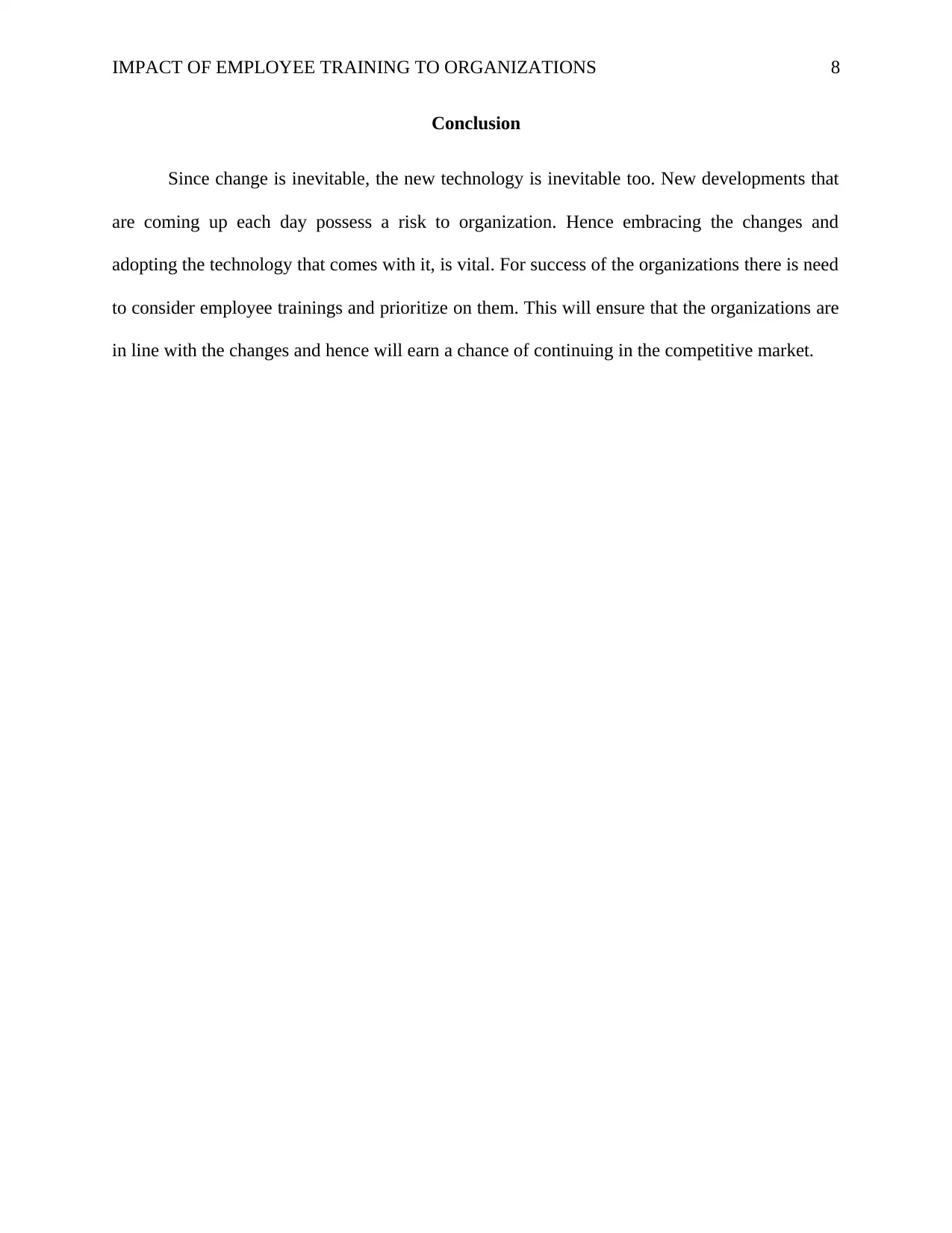
IMPACT OF EMPLOYEE TRAINING TO ORGANIZATIONS 8
Conclusion
Since change is inevitable, the new technology is inevitable too. New developments that
are coming up each day possess a risk to organization. Hence embracing the changes and
adopting the technology that comes with it, is vital. For success of the organizations there is need
to consider employee trainings and prioritize on them. This will ensure that the organizations are
in line with the changes and hence will earn a chance of continuing in the competitive market.
Conclusion
Since change is inevitable, the new technology is inevitable too. New developments that
are coming up each day possess a risk to organization. Hence embracing the changes and
adopting the technology that comes with it, is vital. For success of the organizations there is need
to consider employee trainings and prioritize on them. This will ensure that the organizations are
in line with the changes and hence will earn a chance of continuing in the competitive market.
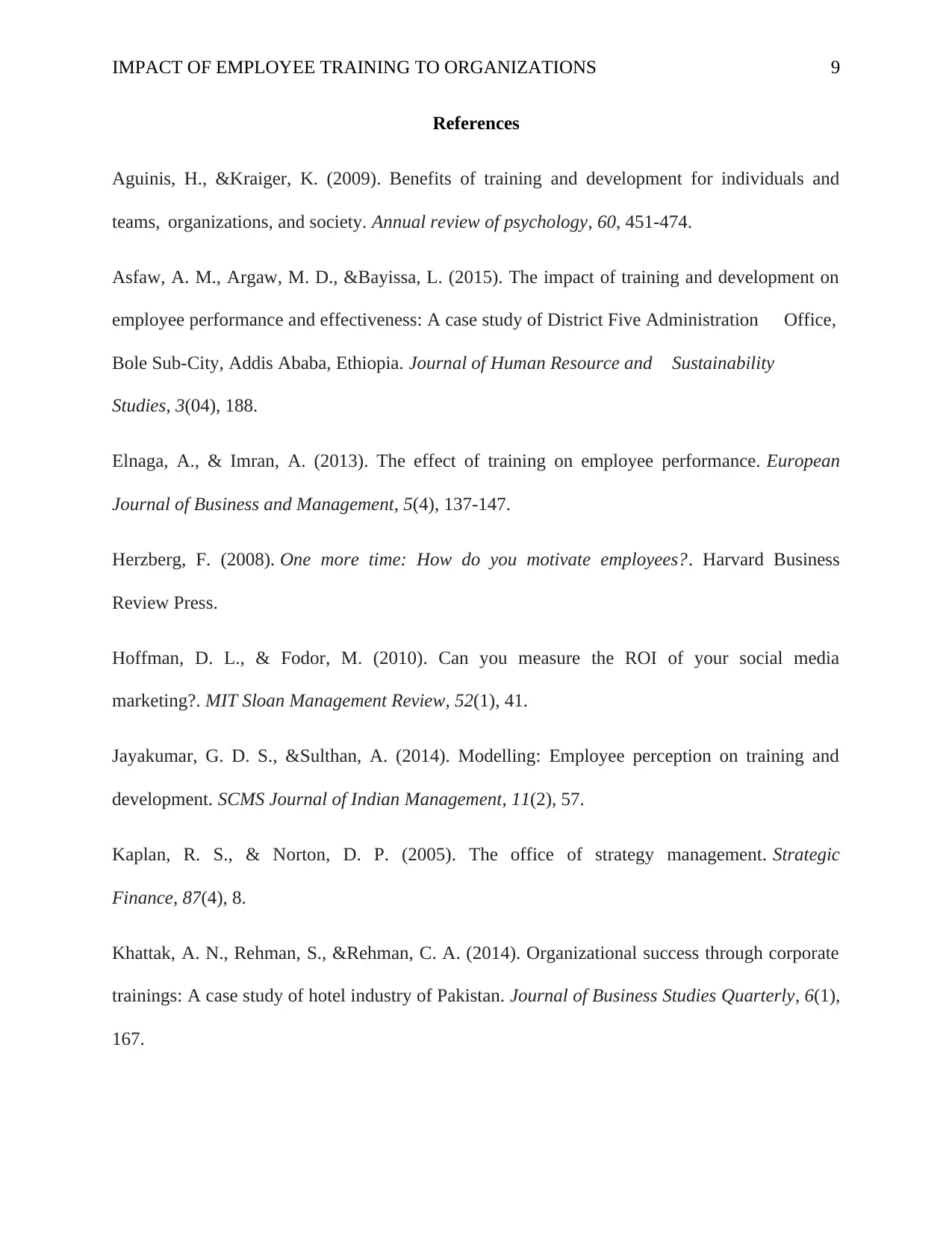
IMPACT OF EMPLOYEE TRAINING TO ORGANIZATIONS 9
References
Aguinis, H., &Kraiger, K. (2009). Benefits of training and development for individuals and
teams, organizations, and society. Annual review of psychology, 60, 451-474.
Asfaw, A. M., Argaw, M. D., &Bayissa, L. (2015). The impact of training and development on
employee performance and effectiveness: A case study of District Five Administration Office,
Bole Sub-City, Addis Ababa, Ethiopia. Journal of Human Resource and Sustainability
Studies, 3(04), 188.
Elnaga, A., & Imran, A. (2013). The effect of training on employee performance. European
Journal of Business and Management, 5(4), 137-147.
Herzberg, F. (2008). One more time: How do you motivate employees?. Harvard Business
Review Press.
Hoffman, D. L., & Fodor, M. (2010). Can you measure the ROI of your social media
marketing?. MIT Sloan Management Review, 52(1), 41.
Jayakumar, G. D. S., &Sulthan, A. (2014). Modelling: Employee perception on training and
development. SCMS Journal of Indian Management, 11(2), 57.
Kaplan, R. S., & Norton, D. P. (2005). The office of strategy management. Strategic
Finance, 87(4), 8.
Khattak, A. N., Rehman, S., &Rehman, C. A. (2014). Organizational success through corporate
trainings: A case study of hotel industry of Pakistan. Journal of Business Studies Quarterly, 6(1),
167.
References
Aguinis, H., &Kraiger, K. (2009). Benefits of training and development for individuals and
teams, organizations, and society. Annual review of psychology, 60, 451-474.
Asfaw, A. M., Argaw, M. D., &Bayissa, L. (2015). The impact of training and development on
employee performance and effectiveness: A case study of District Five Administration Office,
Bole Sub-City, Addis Ababa, Ethiopia. Journal of Human Resource and Sustainability
Studies, 3(04), 188.
Elnaga, A., & Imran, A. (2013). The effect of training on employee performance. European
Journal of Business and Management, 5(4), 137-147.
Herzberg, F. (2008). One more time: How do you motivate employees?. Harvard Business
Review Press.
Hoffman, D. L., & Fodor, M. (2010). Can you measure the ROI of your social media
marketing?. MIT Sloan Management Review, 52(1), 41.
Jayakumar, G. D. S., &Sulthan, A. (2014). Modelling: Employee perception on training and
development. SCMS Journal of Indian Management, 11(2), 57.
Kaplan, R. S., & Norton, D. P. (2005). The office of strategy management. Strategic
Finance, 87(4), 8.
Khattak, A. N., Rehman, S., &Rehman, C. A. (2014). Organizational success through corporate
trainings: A case study of hotel industry of Pakistan. Journal of Business Studies Quarterly, 6(1),
167.
⊘ This is a preview!⊘
Do you want full access?
Subscribe today to unlock all pages.

Trusted by 1+ million students worldwide
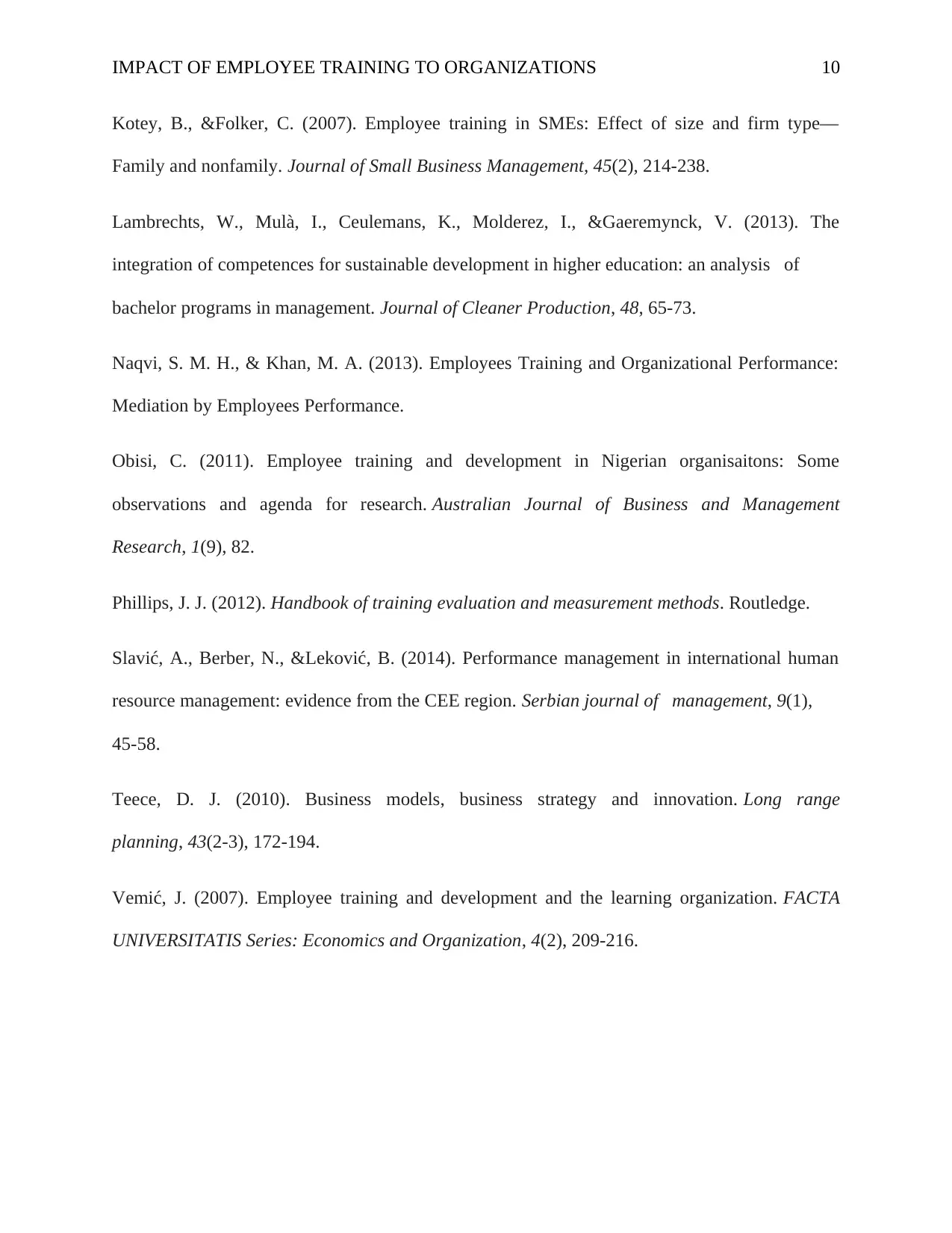
IMPACT OF EMPLOYEE TRAINING TO ORGANIZATIONS 10
Kotey, B., &Folker, C. (2007). Employee training in SMEs: Effect of size and firm type—
Family and nonfamily. Journal of Small Business Management, 45(2), 214-238.
Lambrechts, W., Mulà, I., Ceulemans, K., Molderez, I., &Gaeremynck, V. (2013). The
integration of competences for sustainable development in higher education: an analysis of
bachelor programs in management. Journal of Cleaner Production, 48, 65-73.
Naqvi, S. M. H., & Khan, M. A. (2013). Employees Training and Organizational Performance:
Mediation by Employees Performance.
Obisi, C. (2011). Employee training and development in Nigerian organisaitons: Some
observations and agenda for research. Australian Journal of Business and Management
Research, 1(9), 82.
Phillips, J. J. (2012). Handbook of training evaluation and measurement methods. Routledge.
Slavić, A., Berber, N., &Leković, B. (2014). Performance management in international human
resource management: evidence from the CEE region. Serbian journal of management, 9(1),
45-58.
Teece, D. J. (2010). Business models, business strategy and innovation. Long range
planning, 43(2-3), 172-194.
Vemić, J. (2007). Employee training and development and the learning organization. FACTA
UNIVERSITATIS Series: Economics and Organization, 4(2), 209-216.
Kotey, B., &Folker, C. (2007). Employee training in SMEs: Effect of size and firm type—
Family and nonfamily. Journal of Small Business Management, 45(2), 214-238.
Lambrechts, W., Mulà, I., Ceulemans, K., Molderez, I., &Gaeremynck, V. (2013). The
integration of competences for sustainable development in higher education: an analysis of
bachelor programs in management. Journal of Cleaner Production, 48, 65-73.
Naqvi, S. M. H., & Khan, M. A. (2013). Employees Training and Organizational Performance:
Mediation by Employees Performance.
Obisi, C. (2011). Employee training and development in Nigerian organisaitons: Some
observations and agenda for research. Australian Journal of Business and Management
Research, 1(9), 82.
Phillips, J. J. (2012). Handbook of training evaluation and measurement methods. Routledge.
Slavić, A., Berber, N., &Leković, B. (2014). Performance management in international human
resource management: evidence from the CEE region. Serbian journal of management, 9(1),
45-58.
Teece, D. J. (2010). Business models, business strategy and innovation. Long range
planning, 43(2-3), 172-194.
Vemić, J. (2007). Employee training and development and the learning organization. FACTA
UNIVERSITATIS Series: Economics and Organization, 4(2), 209-216.
1 out of 10
Related Documents
Your All-in-One AI-Powered Toolkit for Academic Success.
+13062052269
info@desklib.com
Available 24*7 on WhatsApp / Email
![[object Object]](/_next/static/media/star-bottom.7253800d.svg)
Unlock your academic potential
Copyright © 2020–2025 A2Z Services. All Rights Reserved. Developed and managed by ZUCOL.



